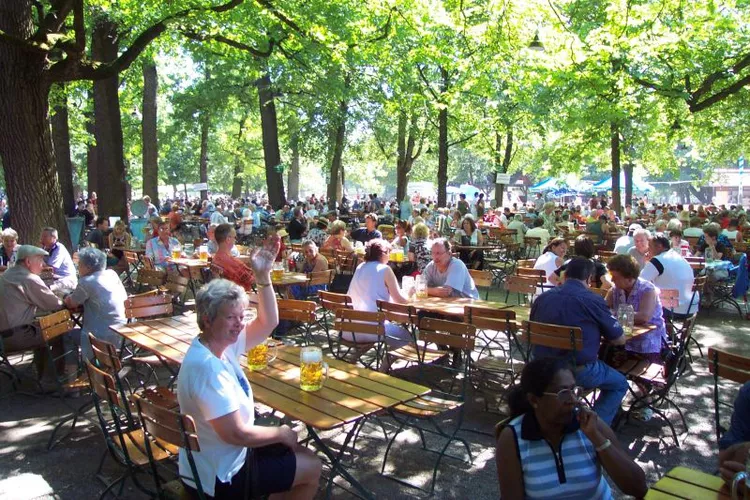1. Overview of German Biergartens
2. History of Biergartens
3. Guide to German Biergartens
4. Food at a German Biergarten
5. Beer at the Biergarten
6. Germany’s Best Biergartens
It is not just for Oktoberfest that Germans gather around long wooden tables to drink endless liters of beer. Biergartens (or simply “beer gardens” in English) open as soon as the chill is gone and continue until the last German gives in to fall. There is just something special about drinking outside.
Discover the rich history of German biergartens, what to eat and drink, and where there are the best beer gardens in Germany.
History of Biergartens
Biergartens have been a constant in Germany since the 18th century. Developed to brew and keep beer in warmer weather, beer cellars were dug into the earth, chestnut trees rose above, and people gathered in-between to drink the fruits of the brewers’ labor.
The popularity of these informal stands threatened traditional taverns. They pleaded their case to Maximilian I, Bavaria’s first king, who signed a royal decree that allowed brewers to sell beer, but not food. People compromised, enjoying the best beers direct from the brewer and bringing a picnic. Thus, the tradition of the biergarten was born.
Several of these early biergartens in Munich are still in operation today. Laws have changed from the olden days so they now serve food along with excellent beers. A tradition that has been exported around the world, visiting a biergarten provides a chance to experience authentic German culture.
Guide to German Biergartens
A biergarten can be found in practically every German dorf (village) and stadt (city). You usually need to look no further than the city’s main square or locate the nearest brewery.
Once you’ve found a gathering of tables beneath the big blue sky, you must find your spot. There are no waiters to escort you to a private table. This is communal seating. If there is an open spot, ask the nearest group, “Ist dieser Platz frei?” (Is this seat taken?) and take your place.
After taking your seat, there is no need to keep socializing. Even though you may be literally rubbing shoulders with the Biergarten-goer next to you, Germans are expert at erecting an invisible wall and preserving their own space in a crowded setting.
Some biergartens have staff that will take orders, but most of the time there is a central beer pouring station where you order and pay, as well as an area to order food. Note that cash is king in Germany and cards may not be accepted at biergartens. Then it is up to you to transfer the massive amounts of food and beer to the table.
Food at a German Biergarten
The first beer gardens were purely drinking establishments with no food provided. Many locations still allow you to bring in your meal.
If you prefer to buy your sustenance, there are many hearty German bites to choose from. Regional specialties pop up in many areas of Germany, but biergarten fare is usually pretty standard. Simple, traditional, and cheap, you can expect to spend around 10 euros for a meal.
- Brotzeit – Some form of “bread time” is the basic snack of the biergarten menu. In Munich this might be black bread, Obatzter (soft white cheese mixed with onions and chives), sausage, pickle, and radish.
- Brezeln (soft pretzel) – The quintessential German snack has a place on almost every Speisekarte (menu).
- Wurst – Another classic, sausage is a favorite of the beer-swilling crowd. In Bavaria, this is usually a Weisswurst (but only before noon). Thuringian Bratwurst is another usual suspect. Around Berlin, you can usually find currywurst on the menu.
- German salads – Offered as sides to some of the meatier options, Kartoffelsalat and Sauerkraut can be found at many a beer garden. However, vegetarians beware that salat does not necessarily mean meat-free. Bacon (speck) can find its way into any German dish.
- Spätzle – An excellent vegetarian option for a belly that needs more than beer, this egg noodle dish is best served with fried onions and lots of cheese.
- Hendl – Half a chicken with a savory rub and garlic sauce is a meal fit for any biergarten barbarian.
- Flammkuchen – This Alsatian thin-crust pizza usually comes with crème fraîche, onions, and – of course – bacon.
- Schweinshaxe – For those with a serious appetite, a huge pork knuckle is the meal of choice. Impress your friends by tearing into this mountain of pork.
Beer at the Biergarten
The most important words at a biergarten: “Ein Mass Bier bitte!“
As many biergartens are attached to a brewery, note that only that brewery’s beer may be served. In general, most breweries serve:
- Helles (light)
- Weizen (wheat)
- Dunkel (dark)
If you would like to enjoy a day at the biergarten without having to spend the next day in bed, you can opt for lighter alcohol content with drinks like a radler – a beer and lemonade mix. For other lightweight options, refer to our list of 8 Non-Alcoholic Summer Drinks in Germany.
Germany’s Best Biergartens
- Munich’s Best Beer Gardens
- Berlin’s Best Biergartens
- Best Biergartens in Dresden
- Beer in Bamberg
While you’re there, you might want to try Leberwurst.




